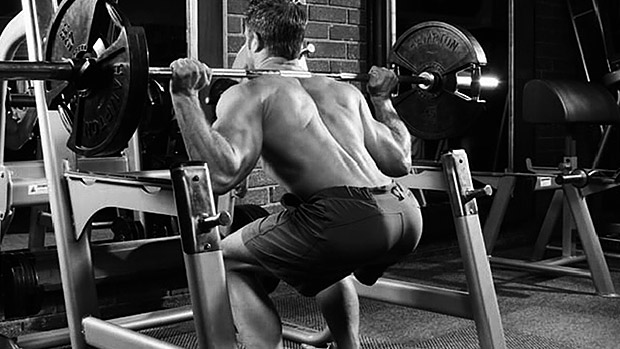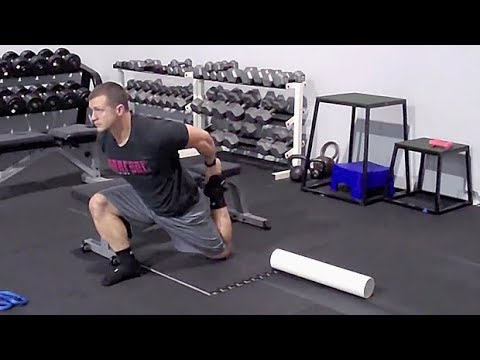"....heavy singles made me bigger and stronger than any other combination of sets and reps I ever tried."
– Brooks Kubick in "Dinosaur Training"
Go to any gym these days and you see most trainees doing an endless number of reps all in the hopes of attaining the oh-so elusive and fleetingly short pump. Blame it on Arnold who, years ago in the movie "Pumping Iron," said that getting a pump was as good as coming, or, in Arnold-ese, comink. Ha!
Regardless, going hard and heavy seems to be a part of some distant past as most people these days think that squat racks are a convenient place to do barbell curls. To make matters worse, many gyms have become magnets for meaningless conversations and look more like places for people to hook up then for serious training to take place.
I'm not sure what's worse, the meaningless conversations or the pseudo lifters that attempt to look serious by growling and grunting with each high-rep set and then browse through the newspaper between each worthless set. Mind you, I'm not saying that high reps are a waste of time. High-rep programs such as the "Super Squats" program produce incredible results and I often do high-rep ballistic sets for high-octane fat burning. However, a very effective and forgotten way to get much stronger and bigger is to do several sets of low reps with short rest periods. One form of this training philosophy is called rest-pause training.
Rest-pause training will separate the serious lifter from the pseudo lifter in no time, as you don't have time to mess around between each set. In additon, this form of training is super intense and requires your full attention.
Bodybuilders during Arnold's competition days used to do rest-pause training from time to time, to get bigger and harder physiques. Mike Mentzer had incredible results with rest-pause training and found it to be an effective way to blast through training plateaus.
Unlike a standard powerlifting routine where you do low reps (1-3 reps) for several sets with long rest periods (3-5 minutes), rest-pause training requires you to take 10-15 second breaks between each set. You're basically taking a short break between each rep in order to use the maximum amount of weight. Since the breaks are short and the weights are heavy, hypertrophy will follow like a charm.
As effective as rest pause training is, it can also be extremely difficult to break into. After all, most people will have trouble taking their one-rep max on the bench press and doing it every 10-15 seconds for 5-6 sets. Chances are they won't get past the second set and will most likely be lucky if they even get that far. Luckily, I recently came up with a way to combine a training approach that I learned from Coach Ethan Reeve of Wakeforest University with rest-pause training to make it much more user friendly.
What you do initially to prepare yourself for modified rest-pause training is to take your three rep max and do ten singles with that weight. Instead of taking only 10-15 seconds between each set, take one-minute breaks between each set.
For most people, this won't be too difficult and that, of course, is the point. I want you to build a pattern of success with a few relatively easy training sessions to prepare you for the brutal rest pause training sessions to follow. Once you can complete all ten singles with one minute breaks, decrease the breaks to 45 seconds between each set. Keep the weight the same.
Once you can complete all ten sets at 45 seconds, go down to 30 seconds. Once you can do that, go to 15 seconds (even though you're only resting 15 seconds, you'll still rack the weight in-between).
At 15 seconds you'll definitely understand how rest-pause training works and you'll love how hard and pumped up your muscles feel after doing several sets. It's much more satisfying then the bloated, soft feel of doing lots of reps with a relatively light weight. If your body-fat is low enough, your veins should look like they're going to explode.
Once you've completed ten sets with 15 second breaks, increase the weight by 10 pounds and go back to one minute breaks between sets. Work your way down the rest pause ladder again until you're back to 15-second breaks. At that point, increase the weight again by another 10 pounds.
After using this method for only ten days, I added 10 pounds to my best overhead press. Before rest-pause training, I had been stuck at a frustrating plateau for months. In additon to the strength increase, I got several comments from friends and family that my shoulders and arms looked much bigger. I was elated to say the least.

The author applies the benefits of Rest-Pause training to lifting an 88 pound kettlebell.
Another benefit to rest pause training is that it gives the CNS (central nervous system) a tremendous boost that's better then any caffeine rush that I've ever experienced. I literally felt invincible and wanted to take the world on after each workout.
At this point you're probably wondering how you could incorporate rest pause training into your program. I never thought you'd ask!
Monday and Friday: Chest, Back, and Biceps
Wednesday and Saturday: Legs and Shoulders
Monday/Friday
Bottom position medium-grip bench presses: 10x1
Note: Do these inside of a power rack. Set the pins as low as possible–making allotments for the width of your chest–and begin the lift from the down position.
Bent-over barbell rows: 10x1
One arm dumbbell curls: 10x1
Wednesday/Saturday
Bottom position squats: 10x1
Note: Do these in a power rack. Put the pins down low and begin the squat from the down position.
Stiff legged deadlifts: 10x1
Standing military presses 10x1
Standing calf raises: 10x1
Rack the weight each time and take one to two minute breaks in between each exercise. Each workout should be pretty brief; not more then 45 minutes, at least in the beginning. As you get better and the rest periods get shorter, you'll take much less time to complete each workout.
As you can see, this is a very simple program and it's meant to be that way! Rest-pause training isn't easy and takes everything that you have. Also, you may have noticed that I haven't added any specific triceps exercises. You'll get all you need with the bottom-position bench presses and the military presses, so leave the triceps-isolation exercises out for five weeks. Regarding abs, feel free to do a few sets of weighted sit-ups, side bends, or windmills after each workout.
I challenge you to give this program a try for five weeks and discover for yourself what the old-time strongmen have known for years: the path to a strong and hard body is paved with heavy, low-rep training.
Let me know how it works out for you.




